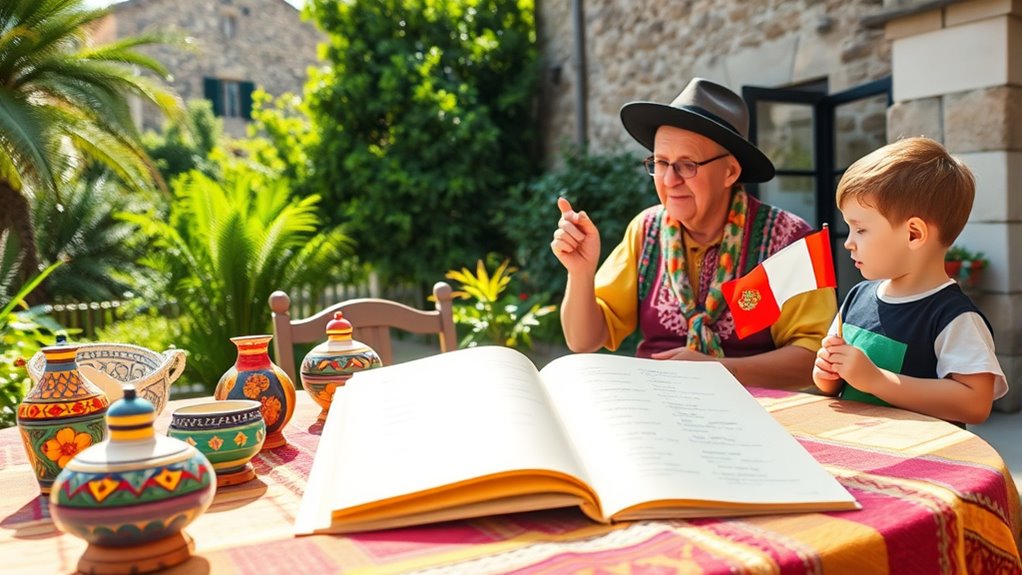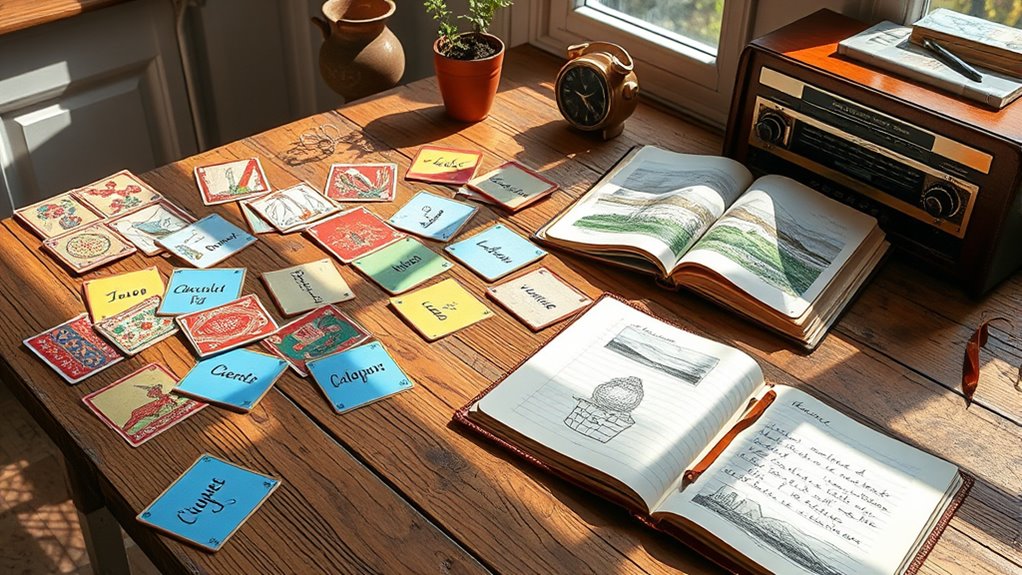Start by learning basic greetings like “Salude” (hello) and “Bona die” (good morning). Choose practical resources such as mobile apps, audio courses, or dialect-specific materials focusing on conversational skills. Build your vocabulary with everyday words, and practice pronunciation with native recordings. Decide whether you’ll focus on Campidanese or Logudorese dialects, and practice speaking with native speakers or language partners. Incorporate Sardinian culture to deepen your understanding—continue exploring to discover even more ways to master the language.
Key Takeaways
- Begin with basic greetings and polite expressions to establish foundational vocabulary.
- Use language learning apps and online resources focused on practical Sardinian phrases and pronunciation.
- Practice listening to native speakers via audio recordings, videos, or dialect-specific materials.
- Study regional dialects like Campidanese or Logudorese to understand pronunciation and cultural context.
- Engage with cultural content such as music, folklore, and festivals to immerse yourself in authentic language use.
Explore Basic Sardinian Greetings and Phrases

Learning basic Sardinian greetings and phrases is essential for making a good first impression and engaging in simple conversations. Starting with greetings like “Salude,” which means “Hello,” helps you connect immediately. Use “Bona die” for “Good morning” or “Good day,” and “Bona tarde” for “Good afternoon.” In the evening, say “Bona notte” to wish someone “Good night.” When saying goodbye, regional terms like “Adiosu” or “Ciauu” work well. Polite phrases such as “Gratzias” (Thanks) and “De nudda” (You’re welcome) show good manners. Questions like “Comment ti jamas?” or “Ite ti nas?” help introduce yourself, while responses like “Appo cumpresu” confirm understanding. Learning these core phrases makes your initial interactions smoother and more respectful. Incorporating cultural communication practices helps establish rapport in Sardinian interactions.
Choose the Right Learning Resources and Tools

To start learning Sardinian effectively, you need to choose the right resources and tools that suit your goals. Consider using software platforms that focus on practical vocabulary, mobile apps for on-the-go practice, and audio materials to improve pronunciation. Combining these resources helps you build a solid foundation in the language quickly and confidently. Additionally, engaging with materials that emphasize regional dialects can deepen your understanding of Sardinian’s diverse linguistic landscape. When exploring different learning options, keep in mind the importance of emotional support to stay motivated and resilient throughout your language learning journey.
Select Suitable Software
Choosing suitable Sardinian learning software involves identifying tools that focus on core vocabulary and practical communication skills. Look for programs like Instant Immersion’s Level 1 Sardinian, which target essential words and phrases for everyday situations. These tools should offer short, engaging sessions—around 10 minutes—to keep you motivated without feeling overwhelmed. Interactive games and quizzes reinforce learning while making it fun. Pronunciation features, such as recording and comparison tools, help you improve your accent with authentic native speaker audio. Many platforms include dialect options, especially Campidanese, to deepen regional understanding. A simple, intuitive interface, accessible on both mobile and desktop, guarantees you can practice anytime. Software Features include a variety of fun games, interactive activities, and quizzes that foster active learning. Supplementary resources like printable phrasebooks and offline materials enhance your learning experience and prepare you for real-world use. Incorporating audio-visual aids can further boost comprehension and retention of regional dialects and pronunciation nuances.
Use Mobile Language Apps
Mobile language apps offer a flexible way to practice Sardinian anytime and anywhere, fitting seamlessly into your daily routine. Choosing the right app depends on your proficiency, goals, and device. For example, GigaSardinian supports multiple languages and emphasizes listening and memorization, perfect for deep comprehension. Sardinian Translator offers real-time translations and cultural insights, helping you grasp idiomatic expressions. LP Sardinian focuses on vocabulary and verb drills, ideal for building foundational skills. uTalk Classic emphasizes spoken phrases and active recall through interactive games, suitable for beginners and intermediate learners. These apps feature audio playback, quizzes, and phrase repetition, making practice engaging. Plus, they support offline access and reminders, so you can learn conveniently during commutes or breaks, ensuring consistent progress. Furthermore, many of these apps are designed to adapt to different learning styles and provide personalized feedback, enhancing your overall language acquisition experience. Additionally, state-specific resources can offer targeted cultural and linguistic insights that deepen your understanding of Sardinian in various contexts.
Incorporate Audio Resources
Wondering how to make your Sardinian learning more effective? Incorporate audio resources tailored to your skill level. Start with platforms like uTalk Sardinian, which offers game-based lessons focused on practical dialogues and pronunciation. Instant Immersion Sardinian provides a quick, downloadable course for rapid conversational skills, while EuroTalk’s Talk Now! delivers foundational vocabulary through quick-start audio lessons. YouTube channels explore Sardinian phonetics, history, and pronunciation, offering authentic listening practice. Surface Languages offers free recordings of phrases in different dialects, ideal for pronunciation and comprehension. Choose resources with native speaker recordings and clear progression from basic to advanced. Regular listening, shadowing, and repeating phrases will reinforce pronunciation, improve understanding, and help you develop a natural accent. Using a variety of audio sources can also keep your learning engaging and help you adapt to different speech patterns and accents. Incorporating audio-based language learning methods supported by research can significantly enhance your ability to acquire pronunciation and comprehension skills effectively.
Focus on Vocabulary Building With Everyday Words

Building a strong foundation in everyday Sardinian words is essential for effective communication. Focus on core vocabulary categories to get started. For example, learn key numbers like “binti” (20), “trinta” (30), and “chentu” (100). Familiarize yourself with basic body parts such as “manu” (hand), “pee” (foot), and “coru” (heart). Explore nature words like “monte” (mountain), “mare” (sea), and “lagu” (lake). Don’t forget essential food terms like “pappare” (to eat), “binu” (wine), and “birra” (beer). Use these words daily by:
Building a solid Sardinian vocabulary boosts everyday communication confidently.
- Memorizing common greetings and polite expressions
- Practicing questions like “Cantu costat?” (How much is this?)
- Repeating verbs like “cantare” (to sing) to build sentences
Developing a personal vocabulary list regularly helps reinforce memory and encourages consistent practice. Incorporating effective learning strategies such as spaced repetition can further boost your retention. This approach helps you communicate confidently in everyday situations.
Understand Sardinian Grammar and Pronunciation Nuances

To understand Sardinian grammar and pronunciation nuances, you need to pay close attention to how the language reflects its Latin roots and regional dialects. Sardinian retains Latin gender distinctions—masculine and feminine—and requires adjectives to agree accordingly. Its sentence structure generally follows a subject-verb-object pattern, similar to Italian and English. Articles are closer to Latin origins, and verb conjugations preserve Latin features, differing from Italian or Spanish. Pronunciation is distinctive, with sounds from Latin that aren’t in standard Italian, influenced by historical substrates. Dialects like Campidanese and Logudorese vary in stress, vowel use, and phonetic details, affecting pronunciation and grammar. Clitic pronouns and word order also showcase Sardinian’s conservative yet unique syntax rooted in Roman and ancient influences. Furthermore, the language’s phonetic nuances are often influenced by regional variations, which can make pronunciation challenging for new learners.
Immerse Yourself in Audio and Listening Practice

Engaging with audio and listening practice is the most effective way to internalize Sardinian pronunciation and rhythm. It helps you attune your ear to the language’s unique cadence, intonation, and phonetic patterns. With dedicated tools like uTalk, Instant Immersion, and EuroTalk, you gain access to hundreds of native speaker recordings, dialogues, and essential phrases. These programs include interactive features such as repetition drills and comparison exercises to refine your pronunciation. Regular listening exposes you to authentic conversations, cultural expressions, and regional variations, improving comprehension and fluency. To make the most of this, you should:
- Practice daily with diverse audio materials like songs and podcasts
- Mimic native speakers through shadowing exercises
- Record yourself and compare to authentic audio for improvement
- Incorporate regional dialects into your listening routine to better understand Sardinian’s linguistic diversity
Additionally, consistent exposure to the language enhances your ability to recognize subtle dialectical differences and regional accents, which are integral parts of Sardinian’s linguistic diversity.
Decide Between Dialects and Regional Variations

You need to choose which Sardinian dialect to focus on, as regional differences influence learning resources and communication. Each dialect varies in pronunciation, vocabulary, and cultural context, so your choice affects your understanding and connections. Consider where you’ll use the language most and which regional variation aligns best with your goals. Additionally, understanding the linguistic features of each dialect can help you make an informed decision based on their historical development and current usage.
Dialect Differences and Similarities
Sardinian dialects share a high degree of lexical similarity, but they differ markedly in pronunciation, vocabulary, and influence from other languages. These differences impact mutual understanding and highlight regional identities. For example, in northern Logudorese, Latin consonant clusters change—/pl/ becomes /pi/—while central Logudorese keeps /pr/. Campidanese, spoken in the south, has more Italian and Catalan influences, resulting in lower lexical similarity to Italian and distinct phonetics. The northern dialects, Sassarese and Gallurese, mix Sardinian with Corsican, Ligurian, and Italian, creating hybrid varieties. These variations reflect historical influences and geographic separation, shaping dialects that are sometimes mutually intelligible but often distinct in sound and vocabulary, emphasizing the rich linguistic tapestry across Sardinia. Additionally, regional dialects have preserved unique grammatical structures and idiomatic expressions that are central to understanding local culture and communication.
Regional Use and Preferences
Regional use of Sardinian varies markedly across Sardinia, influenced by urbanization, education, and local identity. In rural towns, Sardinian is more actively spoken, especially in daily life and community interactions. Conversely, larger cities like Cagliari see less fluent use, with many claiming to speak Sardinian but testing shows lower proficiency. Urban areas favor Italian, reinforced by education and media, which diminishes Sardinian’s public presence. Regional attitudes also differ: rural communities often view Sardinian as a crucial part of their heritage, while some urban residents see it as less practical. Dialect preferences can vary, with some speakers reluctant to adopt standardized forms from other regions. Overall, your choice of dialect or regional variation will depend on where you’re learning and the community’s language habits. Additionally, understanding the various regional variations can help you better appreciate the cultural diversity within Sardinian language use.
Choosing Your Focus Area
Choosing what to focus on when learning Sardinian involves deciding between the various dialects and regional variations. You should consider your interests and goals, as different dialects offer distinct vocabulary, pronunciation, and cultural insights. Here’s a quick overview:
- Logudorese and Campidanese: These are the main dialect groups with different phonetic features and influences from Latin, Catalan, or Italian.
- Northern vs. Central Logudorese: Phonetic shifts vary, but mutual understanding remains. Choose based on regional interest or pronunciation preference.
- Gallurese and Sassarese: These hybrid dialects incorporate Corsican, Ligurian, and Italian elements, reflecting diverse historical influences.
Deciding your focus helps tailor your learning path and connects you more deeply with Sardinian culture.
Practice Speaking With Native Speakers and Language Partners

Practicing speaking with native speakers and language partners is one of the most effective ways to improve your Sardinian skills. It boosts pronunciation, fluency, and listening skills, especially with regional dialects like Campidanese and Logudorese. Real-time feedback helps correct errors and idiomatic expressions. Platforms like uTalk let you compare your pronunciation with native examples. Language exchange offers mutual benefits: you learn, and they practice other languages. Online groups and local meetups increase chances for conversational practice, even exposing you to dialects like Gallurese. Consistent speaking builds confidence and familiarity with everyday phrases, greetings, and cultural expressions. Research shows that speaking practice significantly enhances language retention and speaking confidence. Using interactive tools to simulate conversations can further boost your skills outside of live practice. Use the table below to identify tools and strategies that maximize your practice sessions:
| Tool/Strategy | Focus Area | Benefit |
|---|---|---|
| uTalk | Pronunciation | Immediate feedback |
| Language Exchanges | Dialects | Cultural context |
| Video Calls | Real-time speaking | Confidence boost |
| Language Apps | Vocabulary | Preparation |
| Role-Playing | Social interactions | Fluency development |
Incorporate Cultural Knowledge to Enhance Learning

Understanding Sardinia’s rich history and cultural diversity can substantially deepen your language learning experience. By exploring its past, you’ll grasp why Sardinian is distinct from Italian and appreciate its unique identity. Recognize how centuries of Aragonese, Spanish, Byzantine, and Moorish influences shaped its vocabulary, pronunciation, and traditions. This awareness helps you understand regional dialects like Logudorese and Campidanese, each reflecting different cultural influences. Engaging with Sardinian folklore, music, and festivals brings authentic language use and idioms into your practice. To paint a clearer picture:
- Discover how Spanish and Catalan loanwords reveal historical ties.
- Explore dialectal differences that mirror regional identities.
- Learn about traditional songs and stories that preserve linguistic roots.
- Appreciate how archaeological findings and ancient inscriptions highlight Sardinian’s deep historical roots, enriching your understanding of its unique language development.
This cultural context makes your Sardinian journey more meaningful and memorable.
Establish a Consistent Practice Routine

Establishing a consistent practice routine is essential for steady progress in learning Sardinian. Set specific days and times for study to build habits. Mix structured lessons with informal practice, like chatting with native speakers or listening to Sardinian music. Dedicate at least two sessions weekly to active speaking, such as conversations or language exchanges. Use reminders or calendar alerts to stay on track. Incorporate diverse materials like apps, flashcards, and videos featuring native speakers to improve pronunciation and comprehension. Focus on short-term goals like learning common phrases or mastering 100 new words each month. Track your progress with self-assessments and adjust your goals over time. Consistency in practice is one of the most effective ways to internalize dialect distinctions and overcome language stigma. Regular, focused practice guarantees steady growth and keeps your motivation high.
Frequently Asked Questions
How Long Does It Typically Take to Learn Basic Sardinian?
You’re probably wondering how long it takes to learn basic Sardinian. With formal courses, you can gain foundational skills in about three months, dedicating roughly 30 hours. If you immerse yourself daily through media, conversations, and practice, you can reach basic conversational fluency in about a month. The time depends on your engagement, dialect focus, and practice outside class, but consistent effort speeds up your progress markedly.
Are There Any Free Resources Available for Learning Sardinian?
Seeking solid Sardinian skills? You’ll find fantastic free resources online! Platforms like EuroTalk offer quick, catchy demos, while Memrise and Anki deliver dynamic vocabulary drills. Omniglot provides detailed overviews, and websites share downloadable phrasebooks. Audio samples, pronunciation guides, and beginner courses help hone your hearing and speaking. Engage with energetic online communities, explore dialects, and embrace the language’s rich roots—all without spending a cent.
Which Dialect Should I Focus on for Beginner Learning?
You should focus on either Campidanese or Logudorese for beginner learning. These dialects are the most widely spoken and have the most resources available, making your learning journey smoother. If you plan to spend time in southern Sardinia, Campidanese is a great choice. For a more conservative, Latin-like dialect with rich literary tradition, go with Logudorese. Avoid Sassarese and Gallurese unless you have specific regional ties.
Can I Learn Sardinian Without Speaking Italian First?
Some believe you must speak Italian before learning Sardinian, but that’s not true. You can start learning Sardinian directly, especially with resources designed for beginners. Immersing yourself in Sardinian music, stories, or online courses helps you pick up the language naturally. Engaging with native speakers or communities also boosts your skills. So, don’t let the Italian influence hold you back—dive into Sardinian and enjoy discovering its rich culture.
How Important Is Cultural Knowledge in Learning Sardinian Effectively?
Cultural knowledge plays a essential role when you’re learning Sardinian because it helps you understand the language’s roots, traditions, and social context. By immersing yourself in Sardinian festivals, stories, and customs, you deepen your connection and make learning more meaningful. This awareness boosts your motivation, improves your comprehension, and allows you to speak with authenticity. Embracing Sardinian culture makes your language journey richer and more effective.
Conclusion
Starting your Sardinian journey is like opening a hidden treasure chest of culture and history. With patience and dedication, you’ll find yourself weaving words and sounds into a vibrant tapestry, much like a storyteller from ancient legends. Remember, every phrase learned is a step closer to understanding the island’s soul. Embrace the challenge, stay curious, and soon you’ll be singing the language’s melody, feeling as if you’ve discovered a secret island language only the brave can speak.









